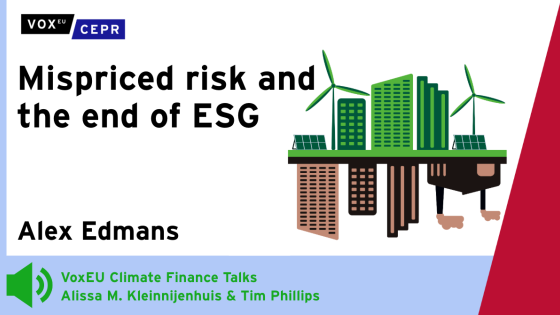Climate policy aims to internalise the social cost of carbon by means of a carbon tax or a system of tradable permits such as the Emissions Trading System set up in the EU. But how do we determine the social cost of carbon? Do we take everything into account that should be taken into account? Most integrated assessment models (Nordhaus 2008, Stern 2007) calculate the net present value of estimated marginal damages to economic production from emitting one extra ton of carbon caused by burning fossil fuel.
However, global warming has many non-marginal effects on both the economy and on the carbon cycle. Climate catastrophes can occur that lead to sudden flooding, hurricanes, desertification, water shortages, etc. Many of such changes may be irreversible. Other catastrophes such as reversal of the Gulf Stream or sudden release of greenhouse gases from the permafrost lead to a sudden and long-lasting change in the system dynamics of the carbon cycle. Such changes in the system dynamics of the economy and/or the carbon cycle are called regime shifts. When such a shift takes place, this is called a tipping point. Scientists predict that at some point, structural changes will occur with effects that are very difficult or even impossible to reverse. The usual marginal cost-benefit analysis of existing integrated assessment models then puts us on the wrong track. The problem is much more serious than we think.
Ecologists have observed tipping points in many ecological systems (e.g. Biggs et al. 2012). For example, lakes shift from states with a high level of ecological services to states with a low level of services when just a little bit more phosphorus is released on the lake, and stay in that state even when the release of phosphorus is reduced again. Another example is the bleaching of coral reefs. When the sea temperature rises just above the normal maximal temperature, the reef flips from a coral-dominated state to an algae-dominated state, which destroys fish populations and tourist assets.
The risk of climate catastrophes
Scientists predict that the climate will show a similar pattern as a consequence of accumulated greenhouse gas emissions, and identify nine types of catastrophe (e.g. Lenton and Ciscar 2013). These catastrophes differ in their impacts on both the economy and the carbon cycle – large or small, global or local, immediate or slowly evolving over time. Scientists have an idea about when catastrophes will happen, but the exact dates of these calamities remain uncertain until they actually occur. It is clear, however, that the probabilities of these hazards occurring are not exogenous, but will typically increase with the stock of greenhouse gases in the atmosphere and temperature. A major worry is thus that global warming leads to an increase in the risk of climate catastrophes and policies should be designed to curb such non-marginal risks. For example, if global warming increases the risk of a sudden and irreversible catastrophic shock to the productivity of the economy, marginal cost-benefit analysis will not suffice.
Optimal saving and carbon pricing under the threat of climate catastrophe
To deal with the stochastic hazard of a climate catastrophe, policymakers need to consider three important effects.
- First, the hazard rate acts as an extra discount rate and therefore induces higher consumption and less saving.
- Second, since economic production and thus consumption will suffer a catastrophic drop after the calamity, it makes sense to accumulate more capital in order to be better prepared for the calamity and to smooth consumption over time.
We show in a simple Ramsey growth framework for the global economy (with fossil fuel input inducing emissions of carbon dioxide) that the net results of these first two effects is precautionary saving and lower consumption before the shock occurs (van der Ploeg and de Zeeuw 2014).
Normally, the steady-state amount of economic activity follows from setting the net marginal product of capital equal to the sum of the depreciation rate and the discount rate, which is the so-called modified golden rule of capital accumulation. However, when having to deal with the prospect of a climate catastrophe, the economy needs to internalise a precautionary return on capital accumulation (thus altering the golden rule) so that the targeted steady-state levels of capital and economic activity are higher than without the anticipation of a hazard of a climate calamity. Precaution is usually formulated as a pragmatic principle of good sense, but in this way it gets a rational underpinning that is actually quite intuitive.
- The third effect is that carbon needs to be priced to curb emissions and eventually curb the stock of atmospheric carbon and temperature, and thereby lower the hazard of catastrophe and postpone the expected date the calamity strikes.
We call this the ‘risk-averting’ part of the social cost of carbon. However, precaution leads to less consumption and more capital, and therefore to more fossil-fuel use. On the other hand, curbing emissions lowers the probability of a shock and therefore the need for precaution. Both actions are required in response to a potential catastrophe, and they have to be balanced in an optimal way. This part of the social cost of carbon comes on top of the net present value of marginal damages before and after the shock. Moreover, a higher stock of atmospheric carbon increases marginal damages after the shock and makes the after-calamity state less desirable. Hence, the social cost of carbon before the shock has a third component that we call the ‘raising-the-stakes’ term.
The effect of tipping points on the social cost of carbon
Most integrated assessment models only focus on the conventional Pigouvian part of the social cost of carbon, i.e. the net present value of the marginal damages that are caused by global warming. But in case of a potential structural catastrophe to the economy, the social cost of carbon has two additional components: a risk-averting component and a raising-the-stakes component. Are we talking about ‘big potatoes’ or ‘small potatoes’ here? In a simple calibration of the world economy on the basis of the BP Statistical Review and the World Bank Development Indicators, we have calculated the relative size of these components for a potential shock equivalent to 20% of total factor productivity.
If the potential tipping point is ignored, our calibration yields, in steady state, a social cost of carbon of $15 per ton of CO2, which is about the same as in well-known integrated assessment models. If the potential tipping point is not ignored, the social cost of carbon increases to $55 or $71 per ton of CO2, depending on whether we take a constant or an increasing marginal hazard rate as a function of the stock of atmospheric carbon. These are big potatoes, we would say. The precautionary returns are 0.6% per year and 0.5% per year, respectively. The need for precaution indeed decreases when emissions are reduced more with a higher tax on carbon.
Splitting the social cost of carbon into the three components provides additional insights. For example, the $71 per ton of CO2 is split into $6 for the marginal damages, $52 for the risk-averting component, and $14 for the raising-the-stakes component. The risk-averting component is by far the largest, and it is clear that ignoring potential tipping points is putting us on the wrong track when discussing climate policy to curb greenhouse gas emissions.
We also investigated a potential catastrophic shock to the capital stock. The effect is not so strong, which is intuitively clear because the economy can recover from such a shock. The drop in total factor productivity has a long-lasting effect, which is exactly what tipping points are all about.
Concluding remarks
Tipping points or regime shifts are usually characterised as large, abrupt and persistent changes. They are very real in ecological systems, and when the economy is embedded in such a system – like the climate system – economic analysis cannot be confined to purely marginal analysis. Integrated assessment models are now starting to include tipping points (Cai et al. 2012, Lemoine and Traeger 2013) but it is still far from common practice.
Finally, a climate policy narrative based on imminent catastrophes and tipping points may resonate more with policymakers than the hitherto-employed narrative based on small costs of marginal changes in global warming at moderate temperatures. And if the earth experiences one or two catastrophic tipping points, this may shock policymakers finally into taking serious and sustained action to combat global warming.
References
Biggs, R, T Blenckner, C Folke, L Gordon, A Norström, M Nyström, and G Peterson (2012), “Regime shifts”, in A Hastings and L Gross (eds.), Encyclopedia of Theoretical Ecology, Berkeley and Los Angeles: University of California Press: 609–616.
Cai, Y, K L Judd, and T S Lontzek (2012), “The social cost of abrupt climate change”, mimeo, Hoover Institution, Stanford University.
Lemoine, D M and C P Traeger (2013), “Watch your step: optimal policy in a tipping climate”, American Economic Journal: Economic Policy, 6(1): 137–166.
Lenton, T M and J-C Ciscar (2013), “Integrating tipping points into climate impact assessments”, Climate Change, 117: 585–597.
Nordhaus, W (2008), A Question of Balance: Economic Models of Climate Change, New Haven, Connecticut: Yale University Press.
Van der Ploeg, F and A de Zeeuw (2014), “Climate Tipping and Economic Growth: Precautionary Saving and the Social Cost of Carbon”, CEPR Discussion Paper 9982.
Stern, N (2007), The Economics of Climate Change: The Stern Review, Cambridge: Cambridge University Press.



